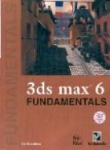|
|
| Book details / order |
| 3DS MAX 6 FUNDAMENTALS |
“what’s new in 3ds max 6? how can 3ds max 6 help me be more productive?” author ted boardman answers all those questions and more in this book. with his guidance, you'll understand not only the process but also the reasoning behind it. following along with the exercises and tutorials provided, you'll discover the new features in version 6 that make max even more powerful and easier to use. whether you're a new user or an old pro looking to increase productivity, you'll benefit from the detailed explanations and thorough exercises on such topics as:
· new global illumination and rendering techniques.
· production techniques for efficient modeling.
· materials application coordinates for convincing rendered surfaces.
· animation techniques and editing tools that enable you to have more control and editing flexibility, including the dope sheet and the curve editor.
· particle system, specially the new particle flow (pflow) system in 3ds max 6, to create the illusion of animated smoke, steam, and more.
· freeform modeling for smooth curved surfaces that can be molded similar to clay sculpting.
table of contents:
introduction.
i. introduction.
1. workflow: keeping the process running smoothly.
in this chapter. key term. preparation and planning. execution. integration and output. summary.
2. important fundamental concepts in 3ds max 6.
in this chapter. key terms. coordinate systems in 3ds max 6. summary. layers. settings and startup configuration. lofting basic concepts. summary.
ii. outdoor scene with ship.
3. fundamental modeling techniques: the building blocks.
in this chapter. key terms. standardizing your display space. 2d shapesa foundation of efficient modeling. 2d shape sub-object editingpractical applications. modifiers and the modify stack. alignment tools and grids. summary.
4. shipbuilding 101: the making of a boat.
in this chapter. key terms. primitive objects and editable poly: a starting point. box modeling from a background image. building superstructure with new modifiers. the lathe and shell modifiers. spacing tool and renderable splines. merging objects from other 3ds max files. summary.
5. creating convincing terrain.
in this chapter. key terms. tracing contour maps to create 3d terrain: the process. creating the terrain, water, and sky. creating low-polygon trees. building a scene in a collaborative environment. cutting a boat ramp into terrain. summary.
6. fundamental outdoor lighting with standard lights.
in this chapter. key terms. the sunlight system. adding fill lights to simulate bounced light. shadow optimization. lighting the skydome. summary.
7. introduction to materials and mapping.
in this chapter. key terms. the material editor. materials with procedural maps as patterns. material libraries to store materials. summary.
8. the fundamentals of scanline rendering.
in this chapter. key terms. the renderers. the rendering process. network rendering. summary.
iii. interior of ships bridge.
9. diving deeper into modeling techniques.
in this chapter. key terms. command center honeycomb walls. a modeling technique called lofting. summary.
10. modeling with patch surfaces.
in this chapter. key terms. organic modeling with spline cages and patch surfaces. editing the patch surface. summary.
11. materials and mapping: a different approach.
in this chapter. key terms. real-world mapping coordinates. multiple materials on single objects. working with shaders to control specular highlights. other productive material attributes. summary.
12. photometric lighting: bounced light calculation.
in this chapter. key terms. photometric lights. meshing parameters for a better radiosity solution. modeling issues with radiosity renderings. summary.
13. radiosity rendering: material control.
in this chapter. key terms. material issues with radiosity rendering. exposure control options. summary.
iv. setting things in motion.
14. set key animation.
in this chapter. key terms. hierarchical linking and dummy objects. summary.
15. controllers/constraints.
in this chapter. key terms. summary.
16. graph editors.
in this chapter. key terms. graph editors. summary.
v. special effects.
17. reactor.
in this chapter. key terms. reactor. summary.
18. pflow.
in this chapter. key terms. pflowthe powerful new particle system. summary.
Author : Broaderman
Publication : Bpb
Isbn : 978-81-7635-729-6
Store book number : 103
NRS 312.00
|
 |
|

|
|
|
|
|
|
| |
|
|